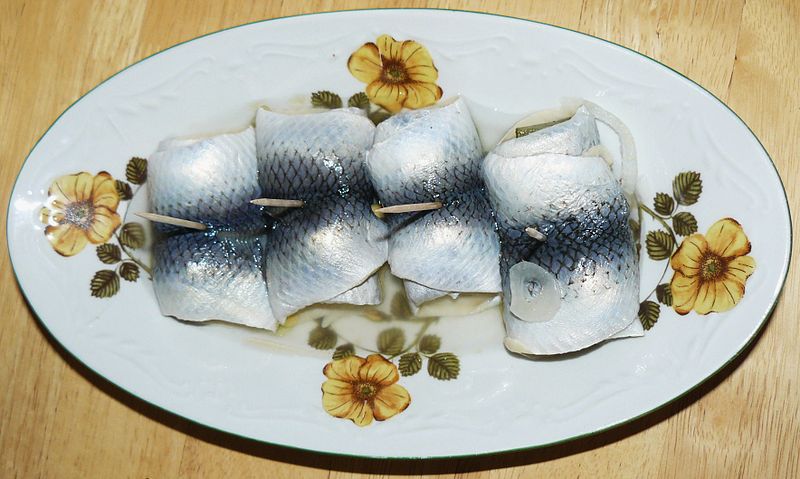Downloads:

Pickling
Vinegar marinade
Keywords
Pickling, vinegar marinade, food conservation, food preservation, salt, vinegar, acidification
Level

Pickling
Pickles are the result of a food preservation technique (acidification) through immersion in water and vinegar in equal parts for a week, on average. It is possible to make pickles from different food groups.
The food product is prepared according to its group (peeling, cutting into equal pieces, …), placed in jars, and preserved for later consumption. Over time, the water and vinegar solution will penetrate the food, modifying its texture and flavour.
It is possible to add some spices (anise, cloves, fennel, black pepper, pink pepper, juniper, ginger, etc.) and aromatic herbs (rosemary, thyme, sage, etc.) to the liquid solution, enhancing different flavours and helping with conservation.
Pickling is also used as a complement to convey a final touch and taste to the dish.
The most common vinegar in this technique is white vinegar. We can also use aged and/or concentrated vinegars (balsamic, red wine, honey, fig …) if we want to change the colour and flavour of the preserve. It is also possible to add sugar, honey or salt to the water and vinegar solution to provide a personal touch to the flavour.
Vinegar marinade
Vinegar marinade is a traditional food preservation technique based on an acidified liquid, aromatic condiments and oil. Basically, wine vinegar, onion, garlic, carrot, cloves, black peppercorns, bay leaf, parsley and olive oil are used. There are three preparation options:
- Hot: the marinade and the food to be preserved are cooked together.
- Cold: the marinade and the food are cooked separately and mixed cold.
- Tempered: the same as the previous one, but they are mixed temperate.
Related to the containers, the best option is to use sterilized glass.
The acidity of the vinegar and the vitamin E of the olive oil (antioxidant) allow the food to be preserved for a considerable period without the need for refrigeration. An example is pickled mussels.
Description
PICKLING AND VINEGAR MARINADE
Pickles are the result of a food preservation technique (acidification) through immersion in water and vinegar in equal parts for a week, on average. It is possible to make pickles from different food groups.
The food product is prepared according to its group (peeling, cutting into equal pieces, …), placed in jars, and preserved for later consumption. Over time, the water and vinegar solution will penetrate the food, modifying its texture and flavour.
It is possible to add some spices (anise, cloves, fennel, black pepper, pink pepper, juniper, ginger, etc.) and aromatic herbs (rosemary, thyme, sage, etc.) to the liquid solution, enhancing different flavours and helping with conservation.
Pickling is also used as a complement to convey a final touch and taste to the dish.
Labels
Benefits
Pickling is used to preserve food, helping to reduce food waste. In addition, it extends products’ shelf life and generates a diversity of textures, flavours and aromas for cooking. It is possible to prepare pickles at home, with our favourite combinations of vegetables and fruits.
Marinating in vinegar is also used to preserve food, helping to eliminate food waste. In addition, the acetic acid in vinegar facilitates the conversion of carbohydrates into energy, which facilitates the conversion of fats into carbohydrates. Lastly, the acid medium that causes vinegar benefits digestion.
Representative Products
Pickling
• Vegetables - garlic, carrots, onions, cucumbers, peppers, cauliflower, broccoli, celery, horseradish, chilis and jalapenos, cornichons, radishes, beets.
• Fruits - mango, cherry, pineapple, pear, apricot, fig.
Vinegar marinade:
• Vegetables: cauliflower, aubergines, courgettes…
• Meats: chicken, turkey, partridge, quail...
• Seafood: mussels and cockles.
• Fish: tuna, sardines, anchovies, mackerel...
Risks
The most common vinegar in this technique is white vinegar. We can also use aged and/or concentrated vinegars (balsamic, red wine, honey, fig …) if we want to change the colour and flavour of the preserve. It is also possible to add sugar, honey or salt to the water and vinegar solution to provide a personal touch to the flavour.
Vinegar marinade is a traditional food preservation technique based on an acidified liquid, aromatic condiments and oil. Basically, wine vinegar, onion, garlic, carrot, cloves, black peppercorns, bay leaf, parsley and olive oil are used. There are three preparation options:
• Hot: the marinade and the food to be preserved are cooked together.
• Cold: the marinade and the food are cooked separately and mixed cold.
• Tempered: the same as the previous one, but they are mixed temperate.
Related to the containers, the best option is to use sterilized glass.
The acidity of the vinegar and the vitamin E of the olive oil (antioxidant) allow the food to be preserved for a considerable period without the need for refrigeration. An example is pickled mussels.
Further references
https://www.theculinarypro.com/marinades
https://www.finecooking.com/article/marinades-add-flavor-but-dont-always-tenderizehttps://www.exploratorium.edu/cooking/pickles/pickling.html
https://www.webmd.com/food-recipes/health-benefits-pickles
 Play Audio
Play Audio

